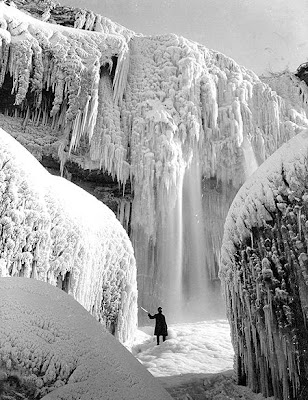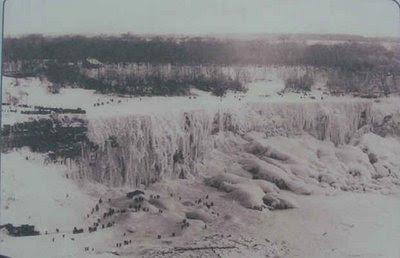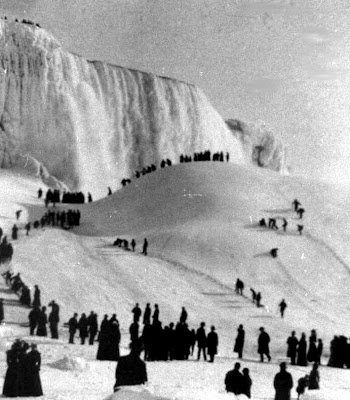This image is displayed on the Niagara Falls Public Library website with the title "American Falls Frozen over with People on the Ice". According to information associated the image, it began circulating on the Internet in 2003 but the original source and date is not known.
The image is also featured on Niagara Falls live.com, and its position in the text suggest that it may be future to show an event in 1848 when the river really stopped flowing completely for a few hours due to an ice jam upstream. Though, it is unclear if the image depicts the actual event describe, or is only used as a general illustration of an ice bridge. This image was apparently derived from an original color postcard titled "Cave of the Winds in Winter Niagara Falls" which was mailed in August 1911. Accurately when the image was created is unclear. The image is also featured on the website of Ellis House, a Bed and Breakfast at Niagara Falls.
This image was apparently derived from an original color postcard titled "Cave of the Winds in Winter Niagara Falls" which was mailed in August 1911. Accurately when the image was created is unclear. The image is also featured on the website of Ellis House, a Bed and Breakfast at Niagara Falls. This image seems to be a cropped version, of a photograph titled "American Falls frozen over" that was taken in 1936. Comments with the uncropped image explain "The miraculous result of a cold winter, the American Falls totally froze in 1936. Notice the tiny human forms at the base of the Falls giving an idea of the density of the ice."
This image seems to be a cropped version, of a photograph titled "American Falls frozen over" that was taken in 1936. Comments with the uncropped image explain "The miraculous result of a cold winter, the American Falls totally froze in 1936. Notice the tiny human forms at the base of the Falls giving an idea of the density of the ice." This image is also included on the Niagara Falls Public Library as well as titled "Great mass of frozen spray and ice-bound American Falls Niagara", by a date of 1902. It originally formed part of a stereo image, a popular medium at the time.
This image is also included on the Niagara Falls Public Library as well as titled "Great mass of frozen spray and ice-bound American Falls Niagara", by a date of 1902. It originally formed part of a stereo image, a popular medium at the time.
Wednesday, June 30, 2010
Very rare photos (Frozen Niagara Falls)
Saturday, June 26, 2010
Bush Dog (Rare animal)
The Bush Dog is a canid found in Central and South America, including Panama, Colombia, Venezuela, Bolivia, Peru, Ecuador, the Guianas, Paraguay, northeast Argentina, and Brazil. In spite of its extensive range, it is very rare; it was originally discovered as fossils in Brazilian caves and thought to be extinct. It is the only living species in its genus, Speothos. In Brazil it is called cachorro-vinagre or cachorro-do-mato. In Spanish-speaking countries it is called perro vinagre, zorro vinagre, perro de agua or perro de monte.
In Brazil it is called cachorro-vinagre or cachorro-do-mato. In Spanish-speaking countries it is called perro vinagre, zorro vinagre, perro de agua or perro de monte.
The Bush Dog has soft long brownish-tan fur, with a lighter reddish tinge on the head, neck and back and a bushy tail, while the underside is dark, sometimes with a lighter throat patch. Adults typically have 55–75 cm (22–30 in) of head and body, plus 13 cm (5 in) of tail, and weigh 5–7 kg (11–15 lb). Legs and snout are short relative to body length: the typical height is only 25–30 cm (10–12 in). The teeth are adapted for its carnivorous habits, and uniquely for an American canid, the dental formula is for a total of 40 teeth. The Bush Dog is one of three canid species with trenchant heel dentition, a unicuspid talonid on the lower carnassial molar that increases the cutting blade length. It is a carnivore and hunts during the day, preferably in wet savannahs and tropical and equatorial forests. Its typical prey is the Paca, a large rodent. Although it can hunt alone on occasion, the Bush Dog is usually found in small packs of up to 10–12 individuals, which can bring down much larger prey. It may be the most gregarious of the South American canid species. Bush Dogs have skin growing between their toes, which allow them to swim more efficiently. It uses hollow logs and cavities for shelter. Pack-mates keep in contact with frequent whines, perhaps because visibility is poor in the undergrowth where the animal typically hunts.
It is a carnivore and hunts during the day, preferably in wet savannahs and tropical and equatorial forests. Its typical prey is the Paca, a large rodent. Although it can hunt alone on occasion, the Bush Dog is usually found in small packs of up to 10–12 individuals, which can bring down much larger prey. It may be the most gregarious of the South American canid species. Bush Dogs have skin growing between their toes, which allow them to swim more efficiently. It uses hollow logs and cavities for shelter. Pack-mates keep in contact with frequent whines, perhaps because visibility is poor in the undergrowth where the animal typically hunts.
The gestation period is 63 days, and a litter can have up to six dark grey pups. Lactation lasts approximately 8 weeks. The Bush Dog is sexually mature at 1 year and lives for about 10 years.
Thursday, June 24, 2010
Legendary Or Rare Animals
Wednesday, June 23, 2010
Rare Baiji Dolphin information
The Baiji was a freshwater dolphin establish only in the Yangtze River in China. Nickname "Goddess of the Yangtze" in China, the dolphin was too called Chinese River Dolphin, Yangtze River Dolphin, Yangtze Dolphin and Whitefin Dolphin.
The Baiji River Dolphin has a thickset body and a long, thin snout, which is not fairly flat and tilt up slightly. Their pectoral fins are small and curved at the tip. A baiji's low triangular dorsal fin is established toward the center of its body.
Baiji Dolphin
Their caudal fin has a middle notch, and is well developed. Their eyes be small and are close to the top of the head.
Tiny ear opening are establish where most other dolphin's eyes are. The Baiji's colors are light, smoked gray, as well as white on the stomach. There is a white collar drawn about the eyes. Inside the lips there are 31 to 36 coned shaped teeth on every jaw.